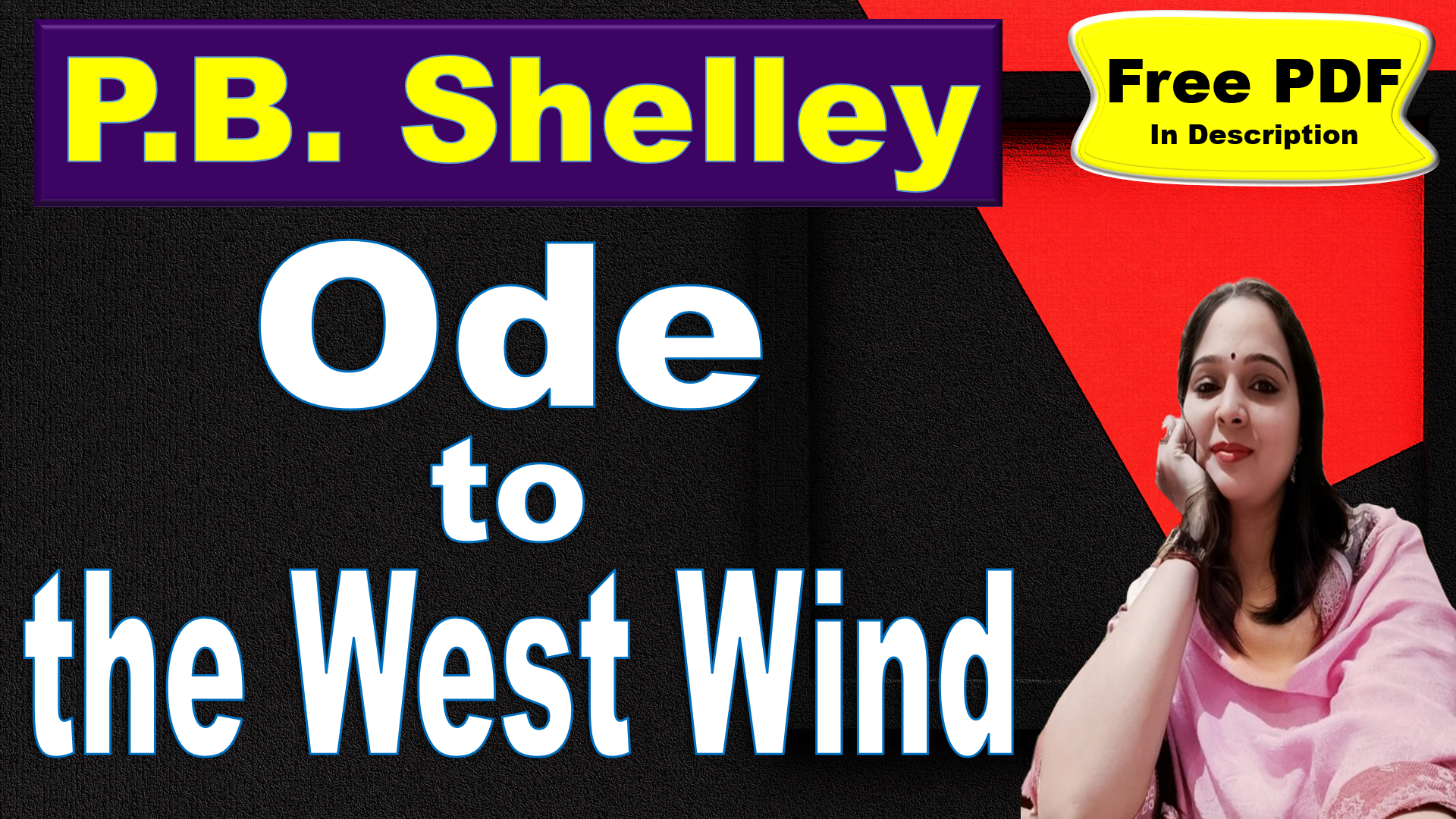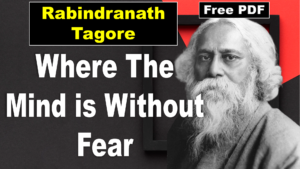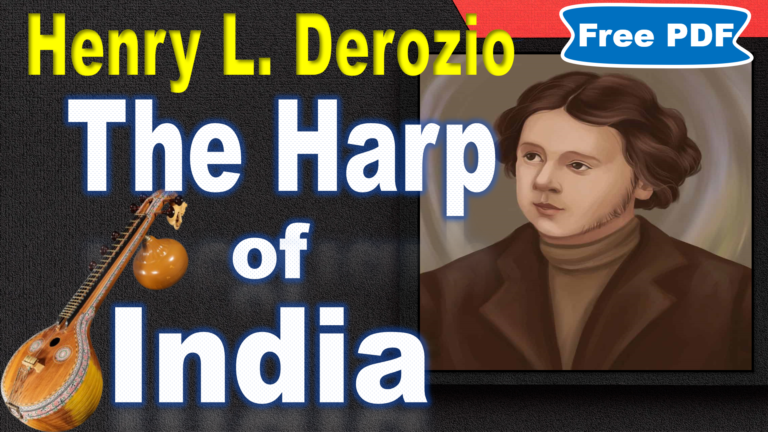Essay Type Questions
Write the critical appreciation of the poem Ode to the West Wind by Percy Bysshe Shelley.
Introduction
Percy Bysshe Shelley’s “Ode to the West Wind” is one of the most celebrated poems of the Romantic era. Written in 1819 and published in 1820 as part of his collection “Prometheus Unbound, with Other Poems,” the poem captures Shelley’s revolutionary spirit, deep connection to nature, and his desire for personal and societal transformation. The poem is a powerful exploration of the forces of nature and their parallels to human emotions, with the West Wind serving as both a literal and symbolic force of change.
Central Idea
The central idea of “Ode to the West Wind” revolves around the theme of transformation through the power of nature. The West Wind is depicted as a force that can both destroy and create, sweeping away the old and making way for the new. Shelley uses the wind as a metaphor for change, expressing his desire to be rejuvenated and to spread his ideas across the world. The poem reflects the poet’s yearning for freedom, renewal, and the power to influence the world through his words.
Structure & Rhyme Scheme
The poem is structured in five cantos, each consisting of 14 lines, making them similar to sonnets. Shelley employs the terza rima rhyme scheme (ABA BCB CDC DED EE), which creates a flowing and interlinked structure that mirrors the continuous movement of the wind. The use of terza rima adds a musical quality to the poem, enhancing its lyrical and rhythmic elements. This structure not only supports the poem’s themes of continuity and change but also reflects the unstoppable force of the wind itself.
Theme
The poem explores several major themes, including the power of nature, change and renewal, the connection between humanity and nature, and the role of the poet. The West Wind symbolizes the forces of change that sweep through both the natural world and human life. The poem also delves into the cyclical nature of life, where destruction is a necessary precursor to renewal. Additionally, Shelley reflects on his own desire to be one with the wind, to harness its power for creative purposes, and to influence the world as a poet.
Style
Shelley’s style in “Ode to the West Wind” is characterized by its emotional intensity, vivid imagery, and rich use of metaphors and symbols. The language is lyrical, with a rhythmic flow that captures the movement of the wind. Shelley’s use of descriptive language creates powerful visual and sensory images that bring the natural elements to life. The poem’s style reflects the Romantic emphasis on individual emotion and the sublime power of nature, making it a quintessential example of Romantic poetry.
Poetic Devices
Shelley employs a variety of poetic devices in the poem to enhance its meaning and impact. Key devices include:
Personification: The West Wind is personified as a powerful and almost divine force, referred to as a “Destroyer and preserver” and a “Spirit fierce.”
Metaphor: The poet uses metaphors like comparing himself to a “lyre” played by the wind and his thoughts to “withered leaves” scattered across the universe.
Simile: Similes are used to draw vivid comparisons, such as the clouds being compared to “earth’s decaying leaves” and the poet’s dead thoughts to “withered leaves.”
Imagery: Vivid imagery is used throughout the poem to describe the wind’s effects on the earth, sky, and sea, creating a dynamic and visual experience for the reader.
Symbolism: The West Wind serves as a symbol of change and transformation, representing both the destructive and creative forces in nature and life.
Critical Commentary
Ode to the West Wind has been widely praised by critics for its innovative use of structure, powerful imagery, and deep exploration of Romantic themes. Critics like F.R. Leavis have noted the poem’s ability to capture the tension between despair and hope, reflecting Shelley’s inner struggles and his belief in the power of renewal. Harold Bloom has emphasized the poem’s visionary quality, seeing Shelley’s use of the West Wind as a symbol of poetic inspiration and revolutionary change. The poem is often discussed in the context of Shelley’s broader body of work, with scholars noting its themes of freedom, political activism, and the role of the poet as a transformative force.
Message
The message of “Ode to the West Wind” is one of hope, renewal, and the inevitable cycle of life. Shelley suggests that even in the face of destruction and despair, there is always the possibility of new beginnings. The poet’s plea to the wind to carry his thoughts across the world reflects his belief in the power of ideas to inspire change. The closing line, “If Winter comes, can Spring be far behind?” encapsulates the poem’s optimistic outlook, reminding readers that after every hardship, renewal is just around the corner.
Conclusion
“Ode to the West Wind” is a masterful exploration of the forces of nature and their parallels to human experience. Through its rich imagery, powerful language, and intricate structure, the poem captures the essence of Romantic poetry, with its emphasis on the sublime, the emotional, and the transformative power of nature. Shelley’s deep connection to the natural world, his revolutionary spirit, and his belief in the potential for renewal make this poem a timeless work that continues to resonate with readers. The themes of change, renewal, and the role of the poet as a voice for transformation are as relevant today as they were in Shelley’s time, making “Ode to the West Wind” a true literary masterpiece.
Long note on themes used in the poem “Ode to the West Wind”
Percy Bysshe Shelley’s “Ode to the West Wind” is a powerful poem that explores several important themes, including the power of nature, change and renewal, the connection between humans and nature, and the role of the poet. These themes are expressed in a way that makes the poem a great example of Romantic poetry.
1. The Power of Nature
One of the main themes of the poem is the incredible power of nature, represented by the West Wind. Shelley describes the wind as a force that can both destroy and create. It blows away dead leaves, scatters seeds, stirs the oceans, and drives clouds across the sky. This shows that nature is a powerful force that can change everything in its path. The poet admires the wind’s ability to bring about these changes and wishes to connect with its power.
2. Change and Renewal
The theme of change and renewal is closely related to the power of nature. Shelley uses the West Wind to show how change is a natural part of life. The wind blows away the old and dead things, like leaves, but it also helps new life to grow by scattering seeds. This theme is especially clear in the final line of the poem: “If Winter comes, can Spring be far behind?” This line suggests that even after difficult times, like winter, new beginnings and growth are always on the way, like spring following winter.
3. Connection Between Humans and Nature
Another important theme in the poem is the connection between humans and nature. Shelley doesn’t see nature as something separate from humans. Instead, he feels deeply connected to it. He wants to be like the wind, to be free and powerful. He wishes the wind could use him as an instrument to express its energy, just as it blows through the trees. This shows how much Shelley values the natural world and sees it as a source of inspiration.
4. The Role of the Poet
Shelley also explores the idea of the poet’s role in society. He believes that, like the West Wind, a poet has the power to inspire and bring about change. In the final part of the poem, Shelley asks the wind to carry his thoughts across the world, hoping they will inspire new ideas and actions. He sees himself as a “trumpet of a prophecy,” someone who can help awaken people to new possibilities. This theme reflects the Romantic idea of the poet as a visionary who can influence the world through their words.
5. Hope and Despair
Throughout the poem, Shelley balances feelings of hope and despair. He expresses sadness about the struggles and challenges he faces in life, feeling weighed down and tired. However, he also holds onto hope, believing in the possibility of renewal and change. The poem ends on a hopeful note with the idea that after winter, spring will surely come, symbolizing new beginnings after tough times.
Conclusion
“Ode to the West Wind” is a poem that explores the power of nature, the inevitability of change, the deep connection between humans and the natural world, and the important role of the poet in inspiring change. Shelley uses the West Wind as a symbol of these themes, expressing his longing for renewal and his belief in the power of change. The poem’s themes of transformation, hope, and the cyclical nature of life make it a timeless and inspiring work.










